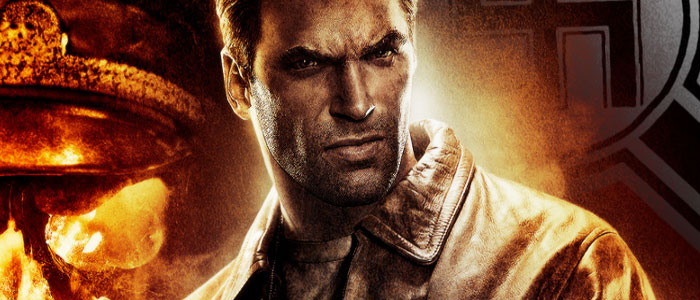Call of Duty casts a long shadow. Like World of Warcraft, it has so mastered its genre that if any other entries in that genre hope for success, they must either ape or wildly deviate from the conventions established by these titles. Wolfenstein gets out its apin’ shoes from the opening scene, a big battle in a train station between resistance fighters and Nazis, with lots of thrilling explosions and exciting setpieces. Until the explosions begin producing antigravity, it feels just like a missing chapter from World at War. You have a compass star to follow from one objective to the next, you have the same damage system – being shot doesn’t kill you, being shot many times at once kills you – you even have the same grenade indicator.
There are worse games to borrow from than Call of Duty, though, and Wolfenstein departs after that first scene. The levels by and large are solitary affairs, pitting the nigh-superhuman B.J. Blazkowicz against an army, just like in the old days. You fight through such exotic settings as “the farm” and “the church” – though most of them end up in some kind of catacombs or another. Linking these is the hub town of Isenstadt, where you can visit the resistance, the enclave of the Golden Dawn, and a few black markets.
You can also search for various artifacts to unlock new weapons and upgrades. Occasionally you run into patrols that must be killed. The hub town provides a greater sense of immersion, and unlocking the upgrades is satisfying, but often it feels like so much padding. Not much actually happens there; it is a place to walk across.
The plot is something you can safely ignore. The Nazis are up to no good; you stop them. No surprises here. Move along. Use the expository scenes to remember all the good times you had shooting Nazis, and happily anticipate shooting more Nazis in the future. B.J. Blazkowicz requires no well developed plot to want to shoot Nazis, and neither do I. Unfortunately, there’s an awful lot of it, so ignoring it takes some work. The Nazis are attempting to master an occult force known as the “Black Sun”; you stop them using the power of the Thule medallion, which allows you to shift into a subdimension called “the Veil”, where there are no shadows and Nazis glow a bright green-blue and weird Lovecraftian ghosts float around, watching and waiting.
While in the Veil, you can (eventually) slow time, raise bulletproof ectoplasmic shields, and walk through doors or climb ladders that only exist in this subdimension. It looks cool, but doesn’t substantially alter gameplay. There are enough Veil-recharge points that you can run around with Veil-vision on almost all the time, shooting your brightly lit opponents from far away, laughing at their meager slow-time attacks while bullets bounce off of you and you shout, “I am B.J. Blazkowicz, All-American killing machine!”
(I recommend playing on the “Hard” setting.)
The graphics are what one expects from a modern AAA title. The Veil effect is very nice, and, occasionally, when around Veil inhibiting machines, the screen will go black-and-white, which is eerie, and reminds me of how much more interesting Saboteur will probably be than this game. No mistake – this is an exciting game – but it is long on polish and short on originality. Nowhere are chances taken. Nowhere is something new done. But it is not a derivation of everything good in modern FPS titles, but a synthesis.
If you’re sick to death of replaying the war that made war seem morally acceptable, there’s no reason to pick this up. The action is about as tight as in World at War, but the hub town kills the momentum. In exchange, though, you get demonic Nazis and fun retro-scifi weapons. If you can’t get enough FPS action, and can’t wait for Modern Warfare 2, this is worth twelve hours of your life.
